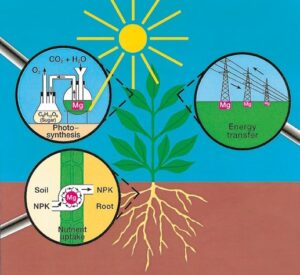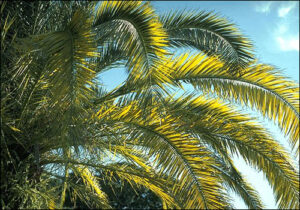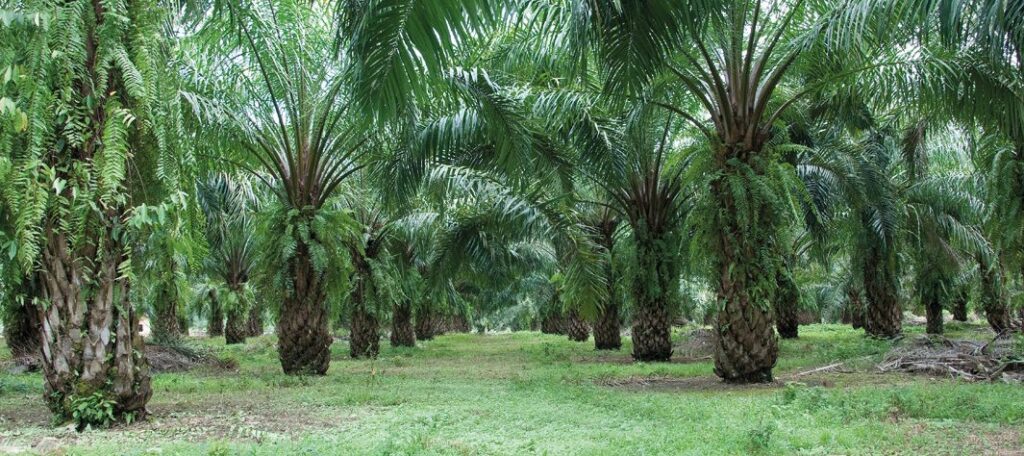Despite being essential for optimal efficiency and return, it seems that it lacks common knowledge of magnesium and how it interacts with soil and Oil Palm. Depicting the function of magnesium for oil palm in this article will help readers understand it.
Magnesium is a vital macronutrient for oil palm and performs several roles in the plant’s metabolic process. Magnesium’s most well-known role in plants is as the centre atom of the chlorophyll molecule. Chlorophyll, the pigment responsible for the green colour of leaves, is essential for photosynthesis, the process through which plants convert sunlight into chemical energy.
Magnesium (Mg2+) is a major counter ion involved in maintaining charge across the chloroplast thylakoid membrane. Magnesium is essential for activating RuBP carboxylase, the primary enzyme in the photosynthetic CO2 assimilation process.

Phosphatases and ATPases both depend on Magnesium for proper operation and activity. This is due to the fact that their cosubstrate, ATP, is always present as its Mg complex and is the sole form in which it is active. When ATP is linked to enzyme proteins, Mg is also needed for bridging. The ATPases are involved in the process of loading the phloem’s, which leads to the subsequent transfer of photosynthates (assimilates) from the leaves to the tissues that sink (fruits roots, fruits and newly sprouting). Starch builds up in leaves as a result of Mg shortage, further restricting photosynthesis via feedback inhibition. Limited photosynthesis results in the creation of oxygen radicals or reactive oxygen species when the energy (light) received by chlorophyll is converted to oxygen (O2) as electrons (ROS). These physiological mechanisms account for the increased susceptibility to high light intensities in Mg-deficient plants.
During the process of protein synthesis, Mg2+ is essential for maintaining the correct orientation of the subunits of the ribosomes, which are in charge of extending the chain of polypeptides that make up the protein. Therefore, Mg is essential for all energy-requiring activities, including starch, protein, and vitamin production, assimilation transfer to roots and fruit bunches, and the activity of various vital enzymes in fatty acid and oil manufacture.
What Is the Major Cause of Magnesium Deficiency in Oil Palm?
Magnesium was formerly ignored in oil palm fields, which resulted in a severe Mg shortage. When the amount of exchangeable Magnesium in the soil is less than 0.2 cmol/kg, oil palms suffer from magnesium shortage. This problem is quite common in areas that have sandy soils and in places where the topsoil has been washed away. Magnesium is naturally scarce in soils that have undergone weathering. Further nitrogen depletion resulted from leaching losses from such soils. Low soil pH accelerates magnesium leaching even more and reduces the retention of Magnesium in the exchange sites. Due to the antagonistic relationship between those cations, high soil concentrations of other cations like K+, Ca+, and NH4+ result in an Mg shortage.
From older to younger leaves and tissues, such as fruits, the free Magnesium is quite mobile throughout the plant. In oil palms, indications of magnesium shortage include a consistent yellowing or vivid orange-yellowing of the elder fronds and leaflets. While leaves exposed to the sun become yellow when there is a magnesium deficit, the shaded portions of the leaves stay green.

In the dry season, when there is a lot of solar radiation and sunshine exposure, there is a severe magnesium deficit. The term “Sun- Scorch” is also used to refer to it in certain regions it figures it out.
The causal impacts, however, include lower Mg absorption and soil mobility due to dry conditions. Low magnesium levels hamper sugar transport and cause the starch to accumulate in leaves. They also cause O2 to be activated, which produces harmful radicals that cause pinnae to chlorosis and necrosis. Thus, “Sun- Scorch” is a sign of latent magnesium shortage in bright light, although shaded pinnae may still be green.
In order to ensure that the oil palm receives a steady supply of this necessary mineral, it is of the highest significance to pay strict attention to the nutrient release properties of the magnesium sources. This is due to the fact that a high FFB yield and high oil extraction rates need magnesium to be available to the plant for an extended period of time. Sources that release energy very slowly may cause a temporary undersupply. On the other hand, swift-releasing sources may be vulnerable to significant Mg losses via leaching.
How to Feed Magnesium to Soil: Best Possible Magnesium Sources
The three primary methods for applying Magnesium to soil are as follows:
1. The carbonate variant (magnesite as well as dolomite)
2. Oxide as a compound (regular magnesium oxide as well as limestone calcined)
3. The Sulphate type (Kieserite and the other magnesium Sulphates).
For Mg fertilizers to be used in oil palm fields, they must have specific physicochemical properties. Typically, the solubility of carbonates and magnesium oxides in water is relatively low. They must be dissolved by soil acidity, which is a drawn-out process that often results in the release of Magnesium at a rate that is too slow to meet crop requirements.
Dolomite is a suitable option for regulating the amount of Magnesium in acidic soils, but since it is insoluble, it is not nearly as efficient as Kieserite for treating magnesium deficiency and supplying Mg to plants.
With both crucial minerals, Kieserite dissolves slowly and independently of pH in the soil, promoting oil palm growth (Mg as well as S).
Kieserite is often more effective than other kinds of magnesium sulphates in the realm of agriculture. Some won’t be readily available to the crops since they contain excessive amounts of Magnesium in oxide form. Others could have a dissolving rate that is too quick, which leads to more leaching loss.
A distinct sort of Magnesium exists in actuality; it is known as Slow-Release Magnesium Natural Release Magnesium. It is a viable solution for cocoa, oil palm, or banana. The magnesium needs are satisfied with a single application each year when it is applied in a circular manner around the trunk.
It may avoid the requirement for fractionation to get the insoluble form, such as magnesium sulphate, thanks to its anti-leaching feature.
To suit the plant’s needs, it enables a controlled release of Magnesium. The formulation with 60 percent MgO offers the maximum blend stability, the lowest risk of magnesium leaching, and good bioavailability.
Because of its high-water disintegration, it enhances root contact.
A plant does discharge organic acids into the soil when it is in the process of growing. SLOW-RELEASE MAG is converted to Mg2+ ions that may be absorbed by the root.
It gradually releases itself into the water, which helps submerged plants like rice to decrease the impact of salt stress.
It is especially appropriate for soils that leach—particularly those that are sandy or superficial—where the water-soluble version is ineffective.


